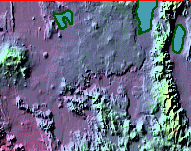

Native Americans of the Region
As we travel through the Lava Beds region, it is appropriate to talk only about the Modoc people. The Modoc were Penutian speakers and are the only Native people of our travel region that are not counted within the California Study Region, as described by the Smithsonian Handbook project. They are, in fact, not considered part of any of the Smithsonian study regions that intersect here --- the Northwest Coast, the Great Basin, and California. The Modoc and the Klamath alike seem to be so completely "transitional" that they have slipped between all of the studies. The Modoc are mostly known for "their war" --- the only Native People of the West Coast who fought a war against Federal troops, much like the wars of the Plains Indians.
The Modoc
Ironically, the Modoc seem to be derived from very ancient Paleo-Indian people of the so-called Llano Complex which emerged as the last Ice Age was disappearing. Archaeological evidence presents us with typical Clovis Points developed in that period for hunting game animals smaller than the big game that had kept Paleo-Indians nomadic. While there are distinct "horizons" of cultural change, the archaeological evidence proceeds toward the present in a continuous chain.
Like the Achumawi, only more so, the Modoc inhabited a region filled with small shallow lakes and marshes. These included the Lower Klamath Lake, Clear Lake, and Tule Lake. The region was well populated with waterfowl since it was directly in line with the Pacific Flyway on its route southwest into the Central Valley. The Modoc and their predecessors thrived on waterfowl meat and eggs and even made feather blankets. Since the abundance of birds went through two annual peaks, corresponding to migration patterns, they even developed techniques for drying meat for use during lean periods of the year.
In the modified archaic tradition of annual rounds, the Modoc built only winter houses as substantial living places. These were semi-subterranean lodges of various sizes (ranging all the way up to thirty feet in diameter). Typical construction principles were followed --- a pit was dug, large lodge poles were installed, smaller beams were spread from central poles to the edges, various materials were used to fill the ceiling, dirt (mud) was layered over the top, and access was made through the smoke hole via a ladder. Menstrual and sweat huts were fashioned as dome-shaped brush houses.
History After White Contact
 The Modoc began seeing White emigrants in 1848-49 but had no trouble with them until an event in 1853 when they became confused with a group of Pit River Indians (Achumawi) who had attacked and killed a party of White emigrants. In the confusion Whites from Yreka killed some Modocs. A few years later, Modocs attacked and killed a party of emigrants at Bloody Point. By the 1870s the succession of conflicts had called sufficent attention to the area that Federal troops had been sent in the area. Fort Klamath and the Klamath Indian Reservation were established just over the border in Oregon. And in November 1872, the garrison received orders from Washington to round up Modoc Indians and send them to the Klamath Reservation. The Modocs responded by fleeing to the Lava Beds, where they took up residence. When Federal troops arrived to remove the Modocs, fighting broke out. Ultimately, some 160 Modocs waged war against approximately one thousand Federal troops in order to retain their homeland strongholds in the Lava Beds. After five deadly battles, the Modoc dispersed but were eventually captured and taken to Klamath Reservation, where this Modoc couple is pictured.
The Modoc began seeing White emigrants in 1848-49 but had no trouble with them until an event in 1853 when they became confused with a group of Pit River Indians (Achumawi) who had attacked and killed a party of White emigrants. In the confusion Whites from Yreka killed some Modocs. A few years later, Modocs attacked and killed a party of emigrants at Bloody Point. By the 1870s the succession of conflicts had called sufficent attention to the area that Federal troops had been sent in the area. Fort Klamath and the Klamath Indian Reservation were established just over the border in Oregon. And in November 1872, the garrison received orders from Washington to round up Modoc Indians and send them to the Klamath Reservation. The Modocs responded by fleeing to the Lava Beds, where they took up residence. When Federal troops arrived to remove the Modocs, fighting broke out. Ultimately, some 160 Modocs waged war against approximately one thousand Federal troops in order to retain their homeland strongholds in the Lava Beds. After five deadly battles, the Modoc dispersed but were eventually captured and taken to Klamath Reservation, where this Modoc couple is pictured.
| Previous Page | Next Page |